 Some friends and I recently had the opportunity to take apart an Olympic torch from the 2008 Beijing Olympics. I've been curious about how olympic torches work, and while I'm still figuring out a few details, here's some of what I know so far, and some photos.
Some friends and I recently had the opportunity to take apart an Olympic torch from the 2008 Beijing Olympics. I've been curious about how olympic torches work, and while I'm still figuring out a few details, here's some of what I know so far, and some photos.
Fully assembled, the torch feels good in the hands. It's has a little heft, but is fairly lightweight and well-balanced. A small hole allows access for an allen wrench to open a valve for lighting.
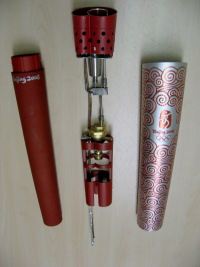 Disassembly was pretty easy. The torch pulls into two pieces at the seam between the orange and metallic parts. A small catch at the bottom of the metallic part releases the innards, and they slip right out the top of the torch. A decorative aluminum casting that surrounds the burners can be removed by taking out two small machine screws. The body is made primarily of aluminum, finished orange. Disassembly was pretty easy. The torch pulls into two pieces at the seam between the orange and metallic parts. A small catch at the bottom of the metallic part releases the innards, and they slip right out the top of the torch. A decorative aluminum casting that surrounds the burners can be removed by taking out two small machine screws. The body is made primarily of aluminum, finished orange.
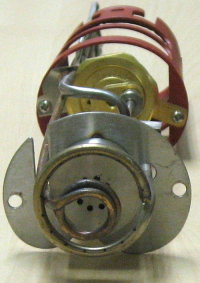 The burner has two components. The center component produces a very hot, blue flame. This kind of flame is hard to blow out, but is also hard to see. The flame comes through the black holes in the plate in the image at right. Surrounding it is a ring of tubing with tiny holes on its inside surface (the largest one in the image at right). The holes in that ring spray extra fuel into the central flame. This fuel burns less efficiently, and would be easy to blow out if the central blue flame wasn't there to keep it lit, but it produces a bright yellow flame that's much easier to see. The smaller coils of tubing are part of a fuel line. More about that below.
The burner has two components. The center component produces a very hot, blue flame. This kind of flame is hard to blow out, but is also hard to see. The flame comes through the black holes in the plate in the image at right. Surrounding it is a ring of tubing with tiny holes on its inside surface (the largest one in the image at right). The holes in that ring spray extra fuel into the central flame. This fuel burns less efficiently, and would be easy to blow out if the central blue flame wasn't there to keep it lit, but it produces a bright yellow flame that's much easier to see. The smaller coils of tubing are part of a fuel line. More about that below.
According to a small card that came with the torch, it was designed to run on pure propane, unlike previous torches which ran on propylene or propane/butane mixtures. This torch was designed to work in very cold environments, like the top of Mount Everest, and propane is a better choice than propane/butane mix because it has a lower boiling point. Propylene would work too, but a propylene flame is unpleasantly sooty. The fuel line passes through the flame before going to the burner to help vaporize the fuel.
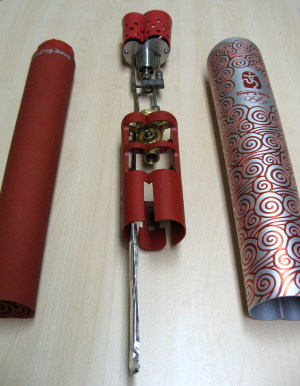 Here's a technical tangent. You can skip this bit if you don't care about thermodynamics. For a fuel like propane or butane to burn, it first has to vaporize, usually through boiling. Liquid butane in a tank boils at -.5C and propane at -42C. Either will boil until the pressure of the vapor contained in the top of the tank becomes too high to allow further boiling. If vapor is being drawn continuously off the tank, and the temperature is above the boiling point, the boiling is continuous. Boiling takes heat, so as long as the fuel is boiling, the tank gets colder and colder. If the temperature falls too far, boiling stops, and no more vapor can be drawn from the tank. Some people call this "freezing" the tank, even though the fuel is not actually frozen. To avoid this problem, it's possible to draw liquid rather than vapor from the tank, and boil it elsewhere. Liquid is drawn by connecting the fuel line to a "dip tube" that reaches all the way to the bottom of the tank. The pressure in the top of the tank pushes the liquid up through the tube. The fuel in the tank only needs to boil enough to maintain pressure in the enclosed headspace, so the tank stays pretty close to the ambient temperature. Here's a technical tangent. You can skip this bit if you don't care about thermodynamics. For a fuel like propane or butane to burn, it first has to vaporize, usually through boiling. Liquid butane in a tank boils at -.5C and propane at -42C. Either will boil until the pressure of the vapor contained in the top of the tank becomes too high to allow further boiling. If vapor is being drawn continuously off the tank, and the temperature is above the boiling point, the boiling is continuous. Boiling takes heat, so as long as the fuel is boiling, the tank gets colder and colder. If the temperature falls too far, boiling stops, and no more vapor can be drawn from the tank. Some people call this "freezing" the tank, even though the fuel is not actually frozen. To avoid this problem, it's possible to draw liquid rather than vapor from the tank, and boil it elsewhere. Liquid is drawn by connecting the fuel line to a "dip tube" that reaches all the way to the bottom of the tank. The pressure in the top of the tank pushes the liquid up through the tube. The fuel in the tank only needs to boil enough to maintain pressure in the enclosed headspace, so the tank stays pretty close to the ambient temperature.
 In this torch, downstream from the tank, the fuel line goes into a little manifold-like block of metal. I'm not certain exactly what's connected where inside the block, so I'm guessing a bit about the following routing. Fuel from the bottle goes to this block, then out to a coil of fuel line that sits right in the flame. Heat from the flame boils the fuel, without risking freezing the tank. The fuel line goes back down through most of the length of the torch. In the lower part of the torch, some thick aluminum tape is stuck to it, to act as a heat sink. That presumably provides some expansion space for the vaporized fuel and helps regulate the rate of vaporization. The fuel line goes back into the manifold block, where it splits into two lines, with one going to each of the two components of the burner. Some folks call this kind of design a self-vaporizing torch. Some liquid fuel rockets, like those on the space shuttle, work similarly. A space shuttle engine's fuel line is part of the rocket cone, so heat from the rocket can preheat the fuel feeding itself. In rocket engines, the flowing fuel is also a coolant. It's absorption of heat from the rocket keeps the cone from melting. When you hear about an olympic torch having "rocket inspired technology", it probably just means the fuel line is heated in the flame. In this torch, downstream from the tank, the fuel line goes into a little manifold-like block of metal. I'm not certain exactly what's connected where inside the block, so I'm guessing a bit about the following routing. Fuel from the bottle goes to this block, then out to a coil of fuel line that sits right in the flame. Heat from the flame boils the fuel, without risking freezing the tank. The fuel line goes back down through most of the length of the torch. In the lower part of the torch, some thick aluminum tape is stuck to it, to act as a heat sink. That presumably provides some expansion space for the vaporized fuel and helps regulate the rate of vaporization. The fuel line goes back into the manifold block, where it splits into two lines, with one going to each of the two components of the burner. Some folks call this kind of design a self-vaporizing torch. Some liquid fuel rockets, like those on the space shuttle, work similarly. A space shuttle engine's fuel line is part of the rocket cone, so heat from the rocket can preheat the fuel feeding itself. In rocket engines, the flowing fuel is also a coolant. It's absorption of heat from the rocket keeps the cone from melting. When you hear about an olympic torch having "rocket inspired technology", it probably just means the fuel line is heated in the flame.
This torch appears complete except for the propane bottle. I'm trying to find one small enough to fit, but they're hard to come by.
Photos by Tim Ledlie and Rich Bodo.
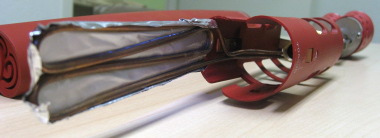
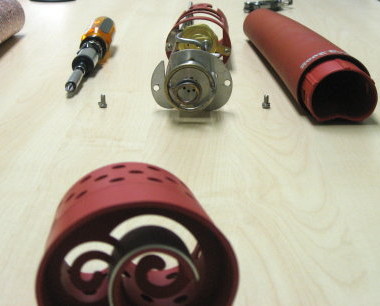
| 
